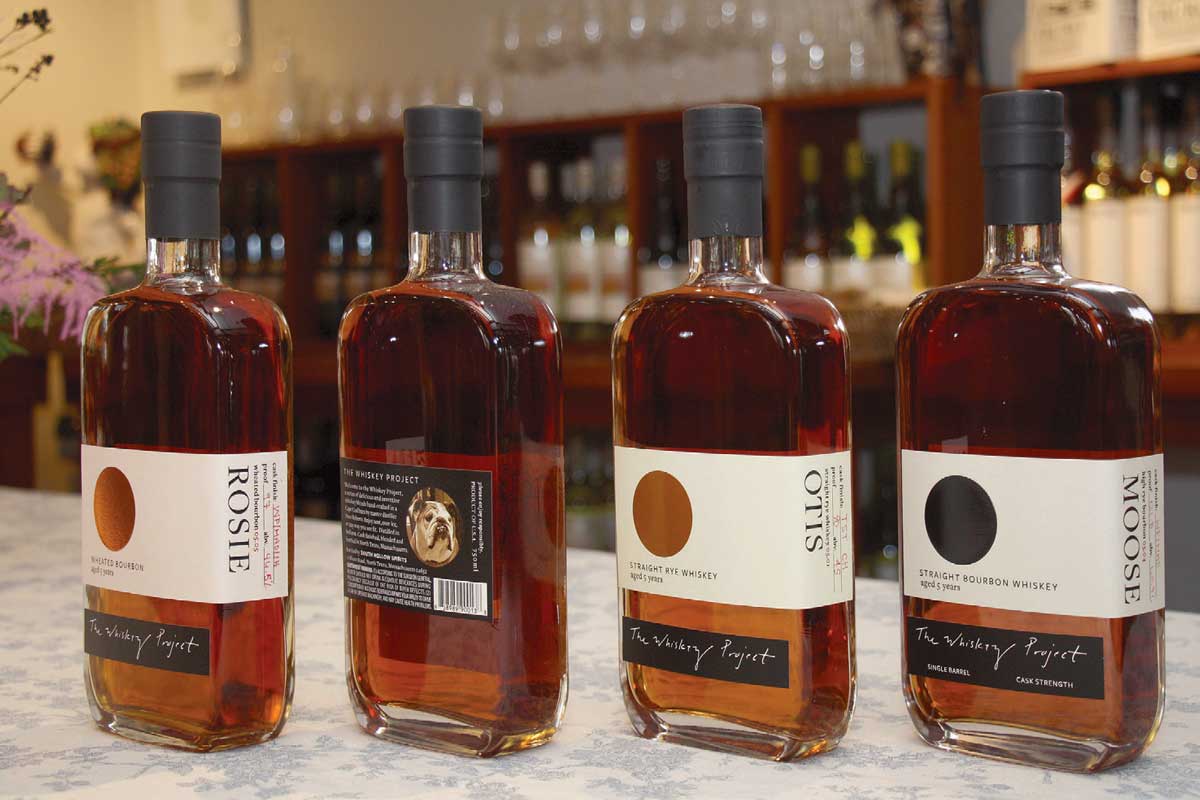Notable edibles-The Whiskey Project
Master distiller Dave Roberts and his crew at South Hollow Spirits are at it again. First came the line of Twenty Boat rums (white, amber, and spiced). Next, Dry Line Gin hit store shelves with its blend of botanicals and juniper berries from the Eastern Red Cedar trees that grow nearby. Two flavors of Amaro followed. Now comes The Whiskey Project. Five varieties in all, the rye whiskeys and bourbons are sourced from Indiana and Kentucky. Roberts and the team place the two-year-old whiskeys in different barrels ranging from charred American, French, or Hungarian oak. Barrels, previously used for chardonnay, sherry, port or Madeira wine, are then used to age the whiskey to five years. The result is a unique flavor for each. For the whiskey enthusiast, all should be tried to find the right taste for you from the ranks of Otis or Daisy (ryes) and Moose or Rosie (bourbons).
The idea had been fermenting in Roberts’ mind for some time. “It was scotches in the ‘90s where I started to see port finished or sherry finished or Madeira cask finished, but you didn’t really see it with whiskeys,” he remembers. After tinkering with port finishing some whiskey, it sparked an idea to source the whiskey and take it from there. “We could do a finishing project, and The Whiskey Project and the idea of the dogs grew from there,” he adds.
The names of The Whiskey Project’s lineup pay tribute to loved ones past and present. “A lot of [whiskey] varieties are named for patriarchal family members,” Roberts explains. “We just thought it’d be a cool concept to pay homage to the family dogs from the past and the present.” Otis, the first whiskey produced, is a rye whiskey named for Dave’s beloved English Bulldog who recently passed. “He lived long enough to see his picture on the bottle, which was cool,” he laughs. Along with Otis, small batches of Ruby and Lucy were launched followed by the two bourbons, Rosie and Moose. Also available is Daisy, another rye whiskey. Each bottle is adorned with a glamour shot of the honored pooch.
Unlike rye whiskey, where the chief ingredient is rye, bourbon, by definition, must be made from at least 51% corn. The secondary grain within the mash bill (the mix of grains to make bourbon) can make a big difference. Replacing the rye with wheat, for example, will soften and sweeten the resulting bourbon. Rosie is a 97-proof wheated bourbon. When sipping the caramel-hued Rosie, the wheat imparts a smoothness that you otherwise wouldn’t find in such a highly proofed bourbon. It’s a great contrast to the cask-strength Moose which is a whopping 121 proof that’ll clear the sinuses while you enjoy notes imparted by the white port/madeira wine barrel in which it’s finished.
The next batch of whiskeys are in their finishing barrels right now. The barrels are then blended to create the flavor profile for which Roberts and crew are looking. They are then proofed down by adding water to lower the alcohol content of each (except Moose). “I start to evaluate them around five or six months,” Roberts says. “I usually find the sweet spot somewhere between seven and nine or ten months.” The new batches of Otis, Moose and Rosie, with their nuanced flavor characteristics and subtle variations of iridescence ranging from golden amber to a deeper chestnut, will be ready by late summer. Depending how the individual barrels finish and their resultant flavor profile, there could be even more specialty releases to come. “Who knows, there may be some small batch stuff that’ll stand out. Only time will tell,” Roberts suggests. In that case, more uniquely “single barrel” batches could be available. Each bottle’s label has the hand-written details for how the whiskey was finished, the proof, and alcohol by volume percentage. A recent batch of Rosie is a blend of bourbon finished in white port, Madeira, and sherry casks. Otis, meanwhile, was finished in toasted Chardonnay casks. “We write them in by hand because the proof can change from batch to batch. The next Rosie might be a little better at 99 or at 90,” he explains. “It all depends on what happens in the barrel.”
In addition to the gift shop of Truro Vineyards, The Whiskey Project’s current lineup can be found at Windmill Liquors in Orleans. The growth of The Whiskey Project is a methodical one due to the production timeline involved. Unlike Twenty Boat rums and Dry Line gin, whiskey needs to age. In getting the whiskey to the five-year mark, storage space is a critical factor as the barrels build up. Soon, the holding facility across the street from the vineyards will be completed, and the capacity of South Hollow Spirits will grow tremendously. You’ll begin to see the sleek bottles across the Cape and beyond. “We want to be able to handle that growth. To support our accounts, and be there when they need more,” says Roberts of the plan going forward. For now, enjoy a beautiful ride to North Truro on a lovely spring day before the crowds descend. As you sit around a fire table on the lawn of Truro Vineyards sipping on a nice red or white, don’t forget to sample a wonderfully rich auburn as well.
Truro Vineyards & South Hollow Spirits
11 Shore Road (Route 6A), North Truro
trurovineyardsofcapecod.com





